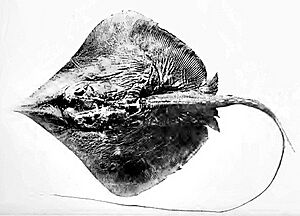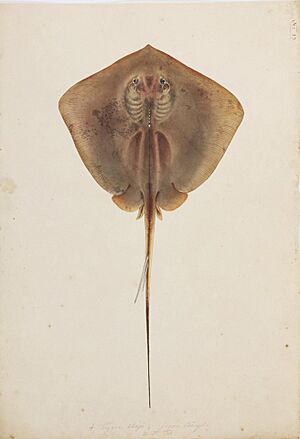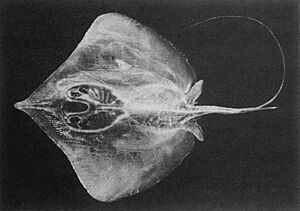Pale-edged stingray facts for kids
Quick facts for kids Pale-edged stingray |
|
|---|---|
 |
|
| Conservation status | |
| Scientific classification | |
| Genus: |
Telatrygon
|
| Species: |
zugei
|
| Synonyms | |
|
|
The pale-edged stingray (Telatrygon zugei), also known as the sharpnose stingray, is a type of stingray. You can find this fascinating fish in the Indian and Pacific Oceans. Its home stretches from India all the way to southern Japan.
This ray loves to live on the ocean floor, especially in sandy areas. It usually stays in waters shallower than 100 meters (330 feet). You might also spot it in estuaries, which are places where rivers meet the sea. The pale-edged stingray can grow up to 29 centimeters (11 inches) across. It has a unique diamond shape and a long, pointed snout. Its tail is like a whip and has special folds on it. This ray is chocolate brown on top and white underneath.
Contents
About the Pale-Edged Stingray
The pale-edged stingray mainly eats small crustaceans and fishes. Female stingrays give birth to live young, usually 1 to 3 babies at a time. Sadly, this species is often caught by accident when people are fishing for other things. Because of heavy fishing, the International Union for Conservation of Nature (IUCN) says it is a Vulnerable species. This means it could become endangered if things don't change.
Who Named This Ray?
Two German biologists, Johannes Müller and Friedrich Henle, were the first to describe the pale-edged stingray. They did this in 1841. They gave it the name Trygon zugei, which came from its Japanese name, zugu-ei. Over time, scientists changed its genus name to Dasyatis and then to Telatrygon.
Where It Lives
The pale-edged stingray lives in a wide area. Its range goes from the Indian subcontinent east to Java and Borneo. It also lives north towards the Philippines and southern Japan. This ray prefers the inner part of the continental shelf, which is the edge of the continent that's underwater. It likes sandy areas that are less than 100 meters (330 feet) deep. It also often swims into estuaries, where fresh and saltwater mix.
What It Looks Like
The pale-edged stingray has a body shaped like a diamond. Its body is a bit longer than it is wide. The front edges of its body curve inward, leading to a long, pointed snout. Its head makes up more than half of its body length! It has small eyes, but behind them are two much larger holes called spiracles. These help it breathe.
Underneath its snout, there's a flap of skin between its nostrils. Its mouth is gently curved. This ray has many rows of teeth, about 40 to 55 in each jaw. These teeth are arranged like a pavement. Adult male stingrays have pointed teeth, while young rays and females have blunt teeth.
The tail of the pale-edged stingray is long and thin, like a whip. It's much longer than its body. It also has a stinging spine, which it uses for defense. There are two folds of skin on its tail: a low one on top and a deeper one underneath. Young stingrays have smooth skin. Older ones have a row of 5 to 9 small bumps in front of their spine.
The top of the ray is a uniform chocolate brown color. The tail folds are a darker brown. The underside of the ray is white, with a brown band around the edge of its body. This species can grow up to 75 centimeters (30 inches) long, but most are about 18 to 24 centimeters (7 to 9 inches) wide.
Life Cycle and Reproduction
The pale-edged stingray mostly eats small crustaceans that live on the ocean floor, especially prawns. It also eats small fishes.
Like other stingrays, the pale-edged stingray gives birth to live young. This is called aplacental viviparous reproduction. The babies first get food from a yolk sac. Later, they get a special "uterine milk" from their mother. Females usually give birth to 1 to 3 babies at a time. There isn't a specific time of year when they reproduce, at least not in places like Indonesia. Newborn rays are about 8 to 10 centimeters (3 to 4 inches) across. Males are ready to reproduce when they are about 18 centimeters (7 inches) wide. Females are ready when they are about 19 centimeters (7.5 inches) wide.
Conservation Status
Many pale-edged stingrays are caught by accident. This happens in fishing nets like bottom trawls and trammel nets. This is especially common in places like the Gulf of Thailand, the Java Sea, and off the coast of India. Most of the rays caught are used for food. However, because they are small, they don't bring in a lot of money for fishers.
The IUCN has listed the pale-edged stingray as Vulnerable. This means its population is decreasing and it faces a high risk of becoming endangered. Fishing pressure is very high and is increasing across most of its habitat. This affects stingrays of all sizes.




